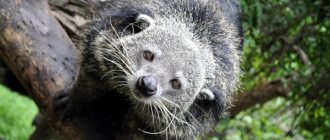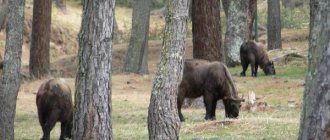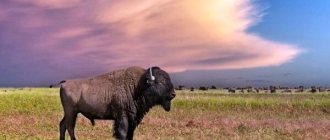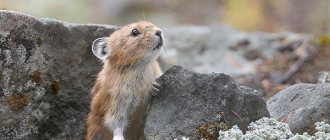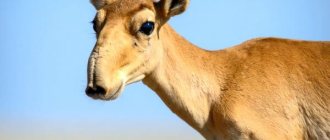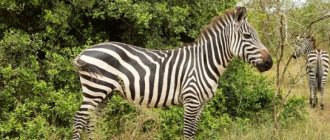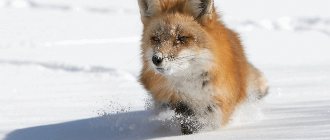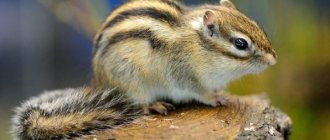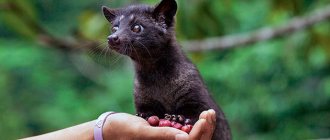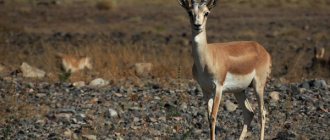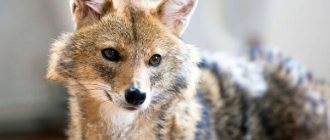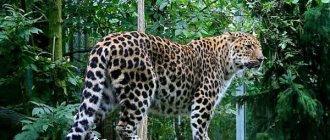Description and distribution
Hyraxes (Hyracoidea) are an order of mammals that includes one family consisting of four species (two diurnal, two nocturnal). The closest relatives of hyraxes (you'll never guess) are elephants. Hyrax is a fairly ancient animal; in the old days, their ancestors were widespread throughout the African continent, but subsequently retreated, unable to withstand the competition with the emerging bovids - antelopes and goats.
The hyrax is a small animal, comparable in size to a cat. The length of an adult hyrax is 30-60 cm, weight 1.5 - 4.5 kg.
Daman
Now hyraxes can be found in northern Africa, Syria and Israel. Hyraxes live in groups of up to 50 individuals. Noticing danger, they notify everyone with piercing screams, like pikas.
Appearance
Hyraxidae (Procaviidae) is the only family of a monotypic order. It includes 4 species of small, stocky herbivorous mammals. Hyraxes live in Africa and the Middle East. Despite the fact that modern hyraxes more closely resemble large rodents, they are actually the closest relatives of elephants, with which they have many similarities in the structure of their teeth, skeleton and placenta.
True, hyraxes are very much smaller in size than their relatives, since they are no larger than a domestic cat: their body length ranges from 30 to 65 cm, with a weight from 1.5 to 4.5 kg. The tail of hyraxes is very short (1-3 cm) or completely absent. Their physique is dense, awkward, with a large head on a short thick neck and short but strong legs. The muzzle of hyraxes is short, with a forked upper lip; The ears are round, small, sometimes almost hidden in the fur. The limbs of these unusual animals are plantigrade; the front ones have 5 fingers with flattened claws resembling hooves; hind limbs three-toed; their inner finger bears a long curved nail, which is used for combing hair, the other fingers have hoof-shaped claws. The soles of the feet of hyraxes are bare, covered with a thick rubber-like epidermis; Numerous ducts of sweat glands open on their surface, which constantly moisturize the skin. The central part of the arch of each foot can be lifted by special muscles, creating a kind of suction cup, and moist skin enhances suction. Thanks to this unusual adaptation for mammals, hyraxes can climb steep cliffs and tree trunks with great dexterity and speed, and even descend from them upside down.
The fur of these animals is thick, formed by soft down and rough awns. On the body (especially on the muzzle above the eyes and on the neck) hyraxes grow tufts of long vibrissae; and in the middle of the back there is an area of elongated, lighter or darker hair, in the center of which there is a bare area, on the surface of which the ducts of a special glandular field open - the dorsal gland of 7-8 lobes, formed by hypertrophied sebaceous and sweat glands. The gland secretes a secretion that smells strongly during the breeding season. In young hyraxes the gland is undeveloped or poorly developed; in females it is smaller than in males. When frightened or excited, the hair covering the gland rises upright. Interestingly, the exact purpose of the gland is still unknown. Adult hyraxes have 34 permanent teeth, and 28 primary teeth. The incisors in their upper jaw are constantly growing, are quite widely spaced and resemble the incisors of rodents; fangs are absent, premolar and molar teeth are similar to the teeth of ungulates.
Features of hyrax
Hyraxes are not very good at maintaining their own body temperature, so they have to huddle in groups at night and bask in the sun during the day, like lizards. The temperature of hyrax can fluctuate between 24-39°C.
When it's cold, hyraxes gather in groups. Photo — koller93
When the animals warm themselves, they try to expose their “palms” - the soles of their paws - to the rays. At the same time, sweat is released on them, which helps the hyraxes climb by wetting the paws, which turn into a kind of suction cups, with the help of special muscles that raise the arch of the foot. Thanks to this know-how, the hyrax can climb and descend even along almost vertical rocks.
Hyraxes have 4 toes on their front legs with flat claws, more like hooves. There are only three toes on the hind legs, two with claws, and the middle one is long and curved.
On the back of the hyrax there is a stripe of longer hair, in the middle of which there is a bare area. When I first saw a hyrax, I thought that the poor thing had lost a tuft of hair. But it turns out that a normal hyrax should look like this. The ducts of a special dorsal gland open onto the bare area of the back - it is assumed that it plays a role in intersexual communication.
Nutrition
Most often, hyraxes prefer to satisfy their hunger with plant foods. But if a small insect or larva comes across their path, they will not disdain them either. In exceptional cases, in search of food, a hyrax can move 1-3 kilometers away from the colony.
As a rule, hyraxes do not need water. The animal's incisors are not sufficiently developed, so they use their molars when feeding. Hyrax has a multi-chamber stomach with a complex structure.
Most often, meals are taken in the morning and evening. The basis of the diet can be not only the green parts of plants, but also roots, fruits, and bulbs. These small animals eat a lot. Most often, this is not a problem for them, because hyraxes settle in places rich in plants.
Enemies of hyraxes
Every desert predator wants to eat hyrax, but their main enemy is the Kaffir eagle, which specializes in catching them.
The Kaffir Desert Eagle is the main enemy of the hyrax
The Damanian people live in constant fear of this bird. In front of the eyes of these animals, evolution even developed a special outgrowth of the iris that protects the pupil. Thanks to these “sunglasses”, our heroes can see the eagle even when looking at the dazzling bright desert sun. True, eagles still sometimes manage to outwit the hyrax; to do this, they maneuver as a pair: one eagle distracts the attention of the victim, and the second attacks unnoticed.
Damaniy watch
Origin
There is an opinion that the “hares” mentioned in the Bible, designated by the word “shaphan” (shaphan), were actually hyraxes. From a distance, hyraxes really resemble large rabbits. From Hebrew this word passed into the language of the Phoenicians, who apparently mistook the rabbits of the Iberian Peninsula for hyraxes, giving the country the name I-Shapan-im, the Shore of Hyraxes. Later, the Latin Hispania and modern "Spain" were derived from this name. The very name “hyrax” is of Arabic origin and literally means “ram”.
Our meeting with the hyraxes
We met hyraxes in the Ein Gedi Nature Reserve, Israel (I wrote about this trip separately - “Ein Gedi - an oasis on the shores of the Dead Sea”). In this oasis, the animals are protected and are not at all afraid of tourists. We were able to touch them, photograph them and get a good look at them. In my opinion, they resemble little bears.
The baby hyrax is not at all afraid of people
Hyraxes living in Israel belong to the genus Cape hyraxes - Procavia capensis. These are exactly what we saw in the Ein Gedi Nature Reserve. Here they are not afraid of people, but in general they are timid animals, although they are curious. Sometimes they even get into houses.
Hyrax is a cautious but curious animal
And a few more of our photos of hyraxes from Israel. I will be glad to comments. Bye!
Hyraxes are studied and protected in the Ein Gedi Nature Reserve
We found hyraxes!
Hyraxes are very inquisitive animals.
Reproduction and lifespan
Scientists have come to the conclusion that there is no seasonality in the reproduction of these animals, or at least it has not been identified. That is, babies appear all year round, but not more than once to the same parents. The female bears offspring for about 7-8 months, most often 1 to 3 cubs are born.
In rare cases, their number can reach up to 6 - this is how many nipples the mother has. The need for breastfeeding disappears within two weeks after birth, although the mother feeds much longer.
The cubs are born quite developed. They see immediately and are already covered with thick fur and are able to move quickly. After 2 weeks, they begin to independently absorb plant foods. Babies are capable of procreation at the age of one and a half years; it is then that the males leave the colony, and the females remain with their family.
Life expectancy varies depending on the species. For example, African hyraxes live 6-7 years, Cape hyraxes can live up to 10 years. At the same time, a pattern was revealed that females live longer than males.
Range, habitats
Rock hyraxes are colonial animals distributed throughout eastern and southern Africa, from southeastern Egypt, Ethiopia and Sudan to central Angola and northern South Africa, including the provinces of Mpumalanga and Limpopo, where habitats include rocky hills, screes and mountain slopes.
Cape hyraxes have become quite widespread from Syria, North-Eastern Africa and Israel to South Africa, and are also found almost everywhere south of the Sahara. Isolated populations are observed in the mountainous landscapes of Algeria and Libya.
Western tree hyraxes live in forest areas in Southern and Central Africa, and are also found on mountain slopes up to an altitude of 4.5 thousand meters above sea level. Southern tree hyraxes have become widespread in Africa, as well as along the Southeast coastal zone.
The habitat of this species extends to the south from Uganda and Kenya to South Africa, as well as from the eastern parts of Zambia and Congo, to the west of the eastern continental coast. The animal lives in mountain lowland and coastal forests.
Return to content
Behavior and nutrition of Cape hyraxes
Hyraxes are social animals, so they live in colonies consisting of several dozen individuals. Each colony is divided into separate families, led by dominant males. Next to the male there are several females with cubs and young males less than 2 years old. The dominant male protects his family members and protects the territory from attack by strangers.
Hyraxes live in colonies. When in danger, they hide among the stones.
Hyraxes are active from morning to evening. During the daytime, they like to rest on rocks and bask in the sun. This activity is the main one for the animals.
The diet of hyraxes consists of grasses, broad-leaved plants, larvae and insects. As a rule, animals do not move further than 50 meters from their shelters. Hyraxes feed in groups, with 2-3 individuals always on guard. If danger threatens, they warn the entire group, which immediately hides among the stones.
Hyraxes can go without water for several days; they only need moisture obtained from plant foods. The animals are good at climbing trees, where they feed on leaves.
Cape hyraxes can live for several days without water.
Sirens
Dugongs and manatees are massive animals (manatees reach a length of 2-4 m and a weight of 200 kg, and dugongs are 2 times larger). Their forelimbs have turned into flippers, their cylindrical body ends in a fin - rounded in manatees and two-lobed in dugongs. The rough, dark brown skin is covered with sparse hair, and a thick layer of fat accumulates under the skin. Externally, sirens resemble walruses without fangs. The entire life of these animals is spent in water; they cannot move on land.
Dugongs usually stay close to the shore at shallow depths in areas where algae accumulate.
They feed on algae, so they live near the coasts of the seas and in the mouths of rivers. Manatees and dugongs are very voracious; they eat 30-50 kg of food per day. Given this feature, manatees are sometimes used to clear vegetation from ponds and canals.
The relationship of these animals with proboscideans is evidenced by the hoof-shaped fingers preserved on the flippers of manatees and the pattern of replacement of molars. Female sirenids, like elephants, have a pair of mammary glands located between the forelimbs. Manatees reproduce very slowly: a female usually gives birth to one baby every 3-5 years, and they live 20-25 years. Even rarer are dugongs, which, unlike manatees, do not tolerate captivity well. Previously, there were quite a lot of dugongs, but their number has sharply decreased due to pollution of the World Ocean with oil products. The number of sirens is declining everywhere; they are listed in the International Red Book and need protection.
The sea cow, or Steller's cow, is an extinct representative of the sirenidae. These were giant animals up to 8 m long and weighing up to 3.5 tons. They were found near the Commander Islands and were discovered in 1741 by members of the expedition of Vitus Bering. Slow and defenseless animals became easy prey for sailors and hunters; as a result of predatory extermination, by 1765 they had disappeared from the face of the Earth.
Population and species status
In Arabia and southern Africa, hyraxes are caught for tasty and nutritious meat, reminiscent of rabbit, which adversely affects the overall population of such a claw-toed mammal. The most vulnerable at present are forest hyraxes, the total number of individuals of which suffers from the cutting down of green areas and other human activities. In general, today the population of all types of hyraxes is quite stable .
Return to content
Links[edit]
- Staff, ID (December 4, 2022). "Dadra & Nagar Haveli and Daman & Diu UTs team up for 'improved administration, service efficiency': MoS Home". Indus Dictum
. Retrieved December 5, 2022. - ↑
Datta, Amrita Nayak (July 10, 2022).
"There will be one less UT as Modi govt plans to merge Dadra & Nagar Haveli and Daman & Diu". Seal
. Retrieved August 22, 2022. - "Government plans to merge 2 UTs - Daman and Diu, Dadra and Nagar Haveli".
- https://164.100.47.4/BillsTexts/LSBillTexts/Asintroduced/366_2019_LS_Eng.pdf
- "Census" (PDF). Census of India
. Ministry of Finance of India. Archived from the original (PDF) on December 19, 2008. Retrieved December 18, 2008. - 2011 census
- "Ranking of States and Union Territories by Population: 1991 and 2001" (PDF). Government of India (2001)
. Census of India. pp. 5–6. Archived from the original on January 2, 2014 (PDF). Retrieved May 12, 2012. - "Daman and Diu". Archived from the original on June 21, 2022. Retrieved July 4, 2022.
- "Language - India, States and Union Territories" (PDF). Census of India 2011
. Office of the Registrar General. pp. 13–14. Archived from the original on November 14, 2022 (PDF). Retrieved December 4, 2022. - "51ST REPORT OF THE COMMISSIONER FOR LINGUISTIC MINORITIES IN INDIA" (PDF). nclm.nic.in.
_ Ministry of Minority Affairs. July 15, 2015. p. 125. Archived from the original (PDF) on February 16, 2022. Retrieved February 15, 2022. - Ward (1998). Gujarat – Daman – Diu: Travel Guide. ORIENT LONGMAN LIMITED. ISBN 9788125013839.
- Singh, K.S.; Solanki, BR; Sinha, N. K.; Pereira, Jaime F. (1994). Daman and Diu. Popular Prakashan. ISBN 9788171547616.
